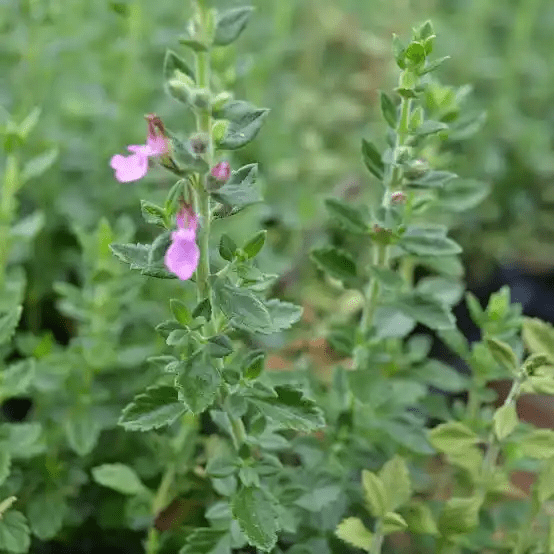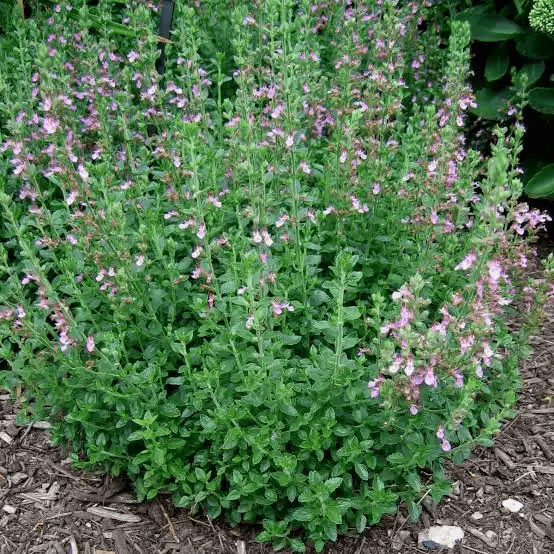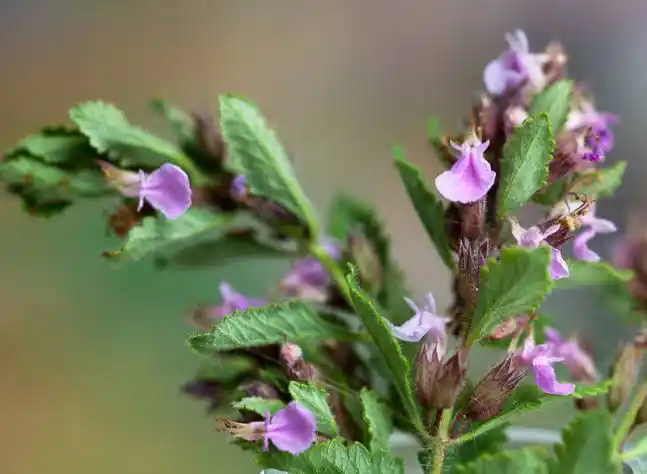Teucrium chamaedrys, commonly known as Germander, is a low-growing, perennial herb that belongs to the mint family, Lamiaceae. This herbaceous plant is native to parts of Europe, including the Mediterranean region, and is well-regarded for its ornamental and medicinal properties.
Germander is characterized by its woody stems, opposite leaves, and spikes of tubular flowers. The leaves are typically small, with a rough texture, and they may be gray-green in color.
The flowers, which appear in whorls along the stems, can range in color from pink to purple. The overall appearance of Germander is compact and bushy, making it a popular choice for edging, rock gardens, and herb gardens.
In addition to its aesthetic value, Teucrium chamaedrys has historical significance. In traditional herbal medicine, various parts of the Germander plant have been used for their purported medicinal properties. The leaves were traditionally employed to make herbal teas believed to have digestive and diuretic benefits.
However, it’s important to note that the use of Germander in herbal remedies should be approached with caution, as some species within the Teucrium genus contain compounds that may be toxic in large quantities.
Cultivating Germander is relatively straightforward, as it is adaptable to various soil types and can thrive in full sun to partial shade. This hardiness, combined with its drought tolerance, makes it a resilient plant in different garden settings.
Regular pruning can help maintain its shape and encourage bushy growth, and Germander can be propagated through both seeds and cuttings.
In summary, Teucrium chamaedrys, or Germander, is a charming and versatile herb with both ornamental and historical significance. Its compact form, attractive flowers, and adaptability make it a valuable addition to gardens, particularly those with a focus on herbs or Mediterranean plants.
As with any herbal use, it’s advisable to exercise caution and consult with knowledgeable sources regarding the potential medicinal properties and any associated risks.
The Botanical Description of Teucrium chamaedrys
1. Growth Form: Teucrium chamaedrys typically exhibits a low-growing, spreading form, forming dense mats or clumps in its natural habitat. The stems are square-shaped, a common trait in Lamiaceae plants, and they produce opposite leaves along their length.
2. Leaves: Small, opposite, lance-shaped leaves characterize Teucrium chamaedrys, with serrated edges enhancing the overall aesthetic appeal. The coloration varies from deep green to grayish-green, providing an additional visual dimension.
3. Flowers: The flowering stage of this species is a spectacle. Small, tubular flowers form in whorls, creating a cluster at the terminal ends of the stems. The color palette ranges from shades of pink to purple, contributing to the plant’s ornamental value.
4. Root System: Teucrium chamaedrys possesses a well-developed root system, providing stability and aiding in water absorption. The robust root structure is adapted to various soil conditions, making the species resilient in different environments.
5. Reproductive Features: Teucrium chamaedrys reproduces through both seeds and vegetative means, ensuring the perpetuation of the species and contributing to its capacity for colonization.
The Geographic Distribution of Teucrium chamaedrys
1. Native Range: Indigenous to the Mediterranean region, Teucrium chamaedrys thrives in well-drained soils and temperate climates, including rocky slopes, dry meadows, and open woodlands.
2. Naturalized Regions: Due to its ornamental appeal and adaptability, this species has been introduced and naturalized in various parts of the world, such as North America and Australia.
3. Habitat Preferences: Teucrium chamaedrys demonstrates versatility in habitat selection, thriving in both sunny and partially shaded locations.
4. Environmental Impact: While appreciated for its aesthetic qualities, the introduction of Teucrium chamaedrys to new regions has raised concerns about its potential invasiveness, impacting local ecosystems.
5. Conservation Status: Monitoring the conservation status of Teucrium chamaedrys is essential, especially in regions where it is not native, informing conservation efforts and managing potential ecological disruptions.
The Chemical Composition of Teucrium chamaedrys
1. Essential Oils: Known for its production of essential oils, Teucrium chamaedrys releases concentrated extracts containing volatile compounds that contribute to its distinctive aroma and may have antimicrobial properties.
2. Terpenoids: The chemical profile includes various terpenoids, such as monoterpenes and sesquiterpenes, contributing to the plant’s fragrance and defense mechanisms against herbivores.
3. Flavonoids: Teucrium chamaedrys contains flavonoids, a diverse group of polyphenolic compounds with antioxidant properties implicated in the plant’s interactions with the surrounding environment.
4. Phenolic Acids: Identified in Teucrium chamaedrys, phenolic acids, including derivatives such as rosmarinic acid, contribute to potential therapeutic applications and may have antioxidant and anti-inflammatory effects.
5. Alkaloids: While not present in high concentrations, some Teucrium species, including chamaedrys, may contain alkaloids, contributing to the overall chemical diversity of the plant.
In conclusion, Teucrium chamaedrys showcases a rich and complex chemical composition, making it a subject of interest not only in botanical studies but also in fields such as pharmacology and ecology. Understanding these chemical components provides valuable insights into the multifaceted nature of this plant species.
Read Also: Bird of Paradise Flower (Strelitzia reginae): All You Need To Know About
The Medicinal Health Benefits Of Teucrium chamaedrys (Germander)

1. Anti-Inflammatory Properties: Teucrium chamaedrys possesses compounds that exhibit anti-inflammatory effects, making it potentially beneficial for managing inflammatory conditions.
2. Digestive Aid: The medicinal properties of germander include aiding digestion, relieving indigestion, and promoting overall digestive health.
3. Antioxidant Action: Teucrium chamaedrys is rich in antioxidants, which can help neutralize harmful free radicals in the body, contributing to overall health.
4. Respiratory Support: The plant may offer respiratory benefits, helping to alleviate symptoms of respiratory conditions and promoting lung health.
5. Antimicrobial Effects: Germander has shown antimicrobial properties, which can contribute to fighting certain infections and promoting immune system health.
6. Diuretic Properties: Teucrium chamaedrys may act as a diuretic, promoting the elimination of excess fluids from the body and supporting kidney function.
7. Cardiovascular Health: The plant has been associated with cardiovascular benefits, including potential effects on blood pressure and cholesterol levels.
8. Wound Healing: Applied topically, germander may aid in wound healing, thanks to its potential antimicrobial and anti-inflammatory properties.
9. Cognitive Support: Some studies suggest that Teucrium chamaedrys may have cognitive-enhancing effects, potentially supporting brain health.
10. Liver Health: The plant may have a positive impact on liver function, supporting detoxification processes within the body.
11. Anti-diabetic Potential: Preliminary research indicates that germander may have anti-diabetic properties, potentially aiding in the management of diabetes.
12. Menstrual Health: Teucrium chamaedrys has been traditionally used to address menstrual issues, offering relief from discomfort and irregularities.
13. Pain Relief: The plant’s anti-inflammatory properties may contribute to pain relief, making it a potential natural remedy for certain types of pain.
14. Antispasmodic Effects: Germander may exhibit antispasmodic effects, making it valuable for relieving muscle spasms and discomfort.
15. Skin Conditions: Applied topically or used internally, Teucrium chamaedrys may have benefits for certain skin conditions, such as eczema or psoriasis.
16. Immune System Support: The plant’s overall medicinal profile suggests potential benefits for the immune system, helping the body defend against infections.
The Methods of Usage to Achieve the Provided Health Benefits Of Teucrium chamaedrys (Germander)
1. Herbal Tea: Prepare an herbal tea using dried germander leaves for a simple way to enjoy its health benefits. Steep for 5-10 minutes and drink.
2. Tinctures: Tinctures offer a concentrated form of Teucrium chamaedrys. Follow dosage instructions provided by a qualified herbalist.
3. Topical Applications: For wound healing and skin conditions, create a poultice or use germander-infused oils for topical application.
4. Culinary Use: Incorporate fresh or dried germander leaves into your culinary creations, adding a flavorful and health-promoting element.
5. Capsules or Supplements: For a convenient option, consider germander capsules or supplements, ensuring you follow recommended dosages.
6. Aromatherapy: Inhaling the aroma of germander essential oil through aromatherapy may offer respiratory and cognitive benefits.
7. Infused Water: Make an infused water by adding fresh or dried germander leaves to water, providing a refreshing way to enjoy its properties.
The Side Effects Of Using Teucrium chamaedrys Medicinal Plant
1. Liver Concerns: Excessive or prolonged use of germander has been associated with liver toxicity. Consult with a healthcare professional before regular use.
2. Allergic Reactions: Some individuals may experience allergic reactions to Teucrium chamaedrys, especially those with known allergies to plants in the Lamiaceae family.
3. Gastrointestinal Distress: In some cases, consumption of germander may lead to gastrointestinal issues such as nausea, vomiting, or diarrhea.
4. Pregnancy and Breastfeeding: Pregnant and breastfeeding individuals should avoid the use of germander, as its safety in these situations is not well-established.
5. Interaction with Medications: Germander may interact with certain medications. Consult with a healthcare professional if you are taking other medications.
6. Neurological Effects: Excessive use may lead to neurological symptoms such as dizziness or confusion. It’s crucial to adhere to recommended dosages.
7. Skin Irritation: Topical applications may cause skin irritation in some individuals. Perform a patch test before widespread use.
8. Not for Prolonged Use: Due to potential side effects, it’s advisable not to use Teucrium chamaedrys for an extended period without professional guidance.
Understanding the potential side effects and using Teucrium chamaedrys in moderation and under the guidance of a healthcare professional can help maximize its benefits while minimizing risks.
Read Also: Guide to Slaughter and Conversion of Muscle to Meat
The Scientific Research and Studies of Teucrium chamaedrys

1. Anti-Inflammatory Properties: Numerous scientific studies have explored the anti-inflammatory effects of Teucrium chamaedrys. Research indicates that the plant’s compounds can modulate inflammatory pathways, suggesting its potential as a natural anti-inflammatory agent.
2. Antimicrobial Activity: Studies have delved into the antimicrobial effects of Teucrium chamaedrys. Research suggests that the plant exhibits inhibitory effects against certain microorganisms, highlighting its potential in combating infections.
3. Antioxidant Potential: Various investigations have focused on the antioxidant capacity of germander. The presence of antioxidants in Teucrium chamaedrys has been linked to neutralizing oxidative stress, offering potential health benefits.
4. Hepatoprotective Effects: Research has explored the hepatoprotective effects of Teucrium chamaedrys on the liver. Findings suggest that the plant may have a positive impact on liver health and function.
5. Cognitive Enhancements: Research into the cognitive effects of germander indicates potential cognitive enhancements. Studies propose that certain compounds in Teucrium chamaedrys may positively influence cognitive function.
6. Immunomodulatory Properties: Scientific studies have investigated the immunomodulatory properties of Teucrium chamaedrys, indicating its potential role in modulating the immune system for optimal function.
7. Gastroprotective Effects: Some research suggests that germander may have gastroprotective effects, providing a protective layer to the stomach lining and potentially aiding in the prevention of gastric issues.
8. Analgesic Effects: Studies have explored the potential analgesic effects of Teucrium chamaedrys, indicating its ability to alleviate pain, making it a potential natural remedy for certain discomforts.
9. Antidiarrheal Properties: Scientific investigations have examined the antidiarrheal properties of germander, suggesting its potential in managing and alleviating symptoms associated with diarrhea.
10. Anti-diuretic Effects: Research indicates that Teucrium chamaedrys may have anti-diuretic properties, potentially regulating excessive urine production and supporting kidney health.
11. Anticancer Potential: Preliminary studies suggest that certain compounds in germander may have anticancer properties, making it a subject of interest for further research in cancer treatment and prevention.
12. Anti-hypertensive Effects: Some research indicates that Teucrium chamaedrys may have anti-hypertensive effects, suggesting its potential role in managing blood pressure.
13. Anti-arthritic Properties: Scientific studies have explored the potential anti-arthritic properties of germander, indicating its ability to mitigate symptoms associated with arthritis.
14. Anti-anxiety Effects: Preliminary research suggests that certain compounds in Teucrium chamaedrys may have anti-anxiety effects, contributing to its potential role in mental health.
15. Antifungal Activity: Studies have investigated the antifungal activity of germander, indicating its potential in combating fungal infections.
16. Anti-viral Properties: Scientific research has explored the anti-viral properties of Teucrium chamaedrys, indicating its potential role in inhibiting certain viruses.
The Safety Precautions and Recommendations In Using Teucrium chamaedrys Medicinal Plant
1. Consultation with Healthcare Professionals: Before incorporating Teucrium chamaedrys into your health regimen, it is crucial to consult with healthcare professionals, especially if you have pre-existing health conditions or are taking medications.
2. Dosage Adherence: Adhere strictly to recommended dosages provided by qualified herbalists or healthcare providers to avoid potential side effects associated with excessive use.
3. Allergic Reactions: Individuals with known allergies to plants in the Lamiaceae family should exercise caution and perform a patch test before using germander to prevent allergic reactions.
4. Monitoring Liver Function: Due to potential liver concerns associated with germander, regular monitoring of liver function is advisable for individuals using Teucrium chamaedrys over an extended period.
5. Avoid During Pregnancy and Breastfeeding: Pregnant and breastfeeding individuals should avoid germander, as its safety in these situations is not well-established.
6. Interaction with Medications: Germander may interact with certain medications. Inform healthcare providers about its use if you are taking other medications.
7. Limited Prolonged Use: To prevent potential side effects, it is advisable not to use Teucrium chamaedrys for an extended period without professional guidance.
8. Individual Sensitivity: Individuals may vary in their sensitivity to Teucrium chamaedrys. Start with small doses to assess individual tolerance and response.
9. Not for Children: The use of germander is not recommended for children due to the lack of sufficient safety data for this age group.
10. Controlled Growing Conditions: For those considering cultivating germander, ensure controlled growing conditions to minimize variability in its chemical composition and potential effects.
FAQs About Teucrium chamaedrys Medicinal Plant
1. Is Teucrium chamaedrys Safe for Long-Term Use?
Teucrium chamaedrys is generally safe when used in moderation. However, prolonged use may lead to liver concerns. Seek professional guidance for long-term use.
2. Can Pregnant Women Use Teucrium chamaedrys?
No, pregnant women should avoid using germander, as its safety during pregnancy is not well-established. Consult with a healthcare professional for alternative options.
3. What Precautions Should Be Taken for Allergic Reactions?
Individuals with known allergies to Lamiaceae family plants should perform a patch test before using germander. Discontinue use if any allergic reactions occur.
4. How Does Teucrium chamaedrys Interact with Medications?
Germander may interact with certain medications. Inform your healthcare provider about its use to ensure there are no adverse interactions with other medications.
5. Are There Alternatives for Teucrium chamaedrys During Pregnancy?
Pregnant women should consult with healthcare professionals for safe alternatives to germander during pregnancy, ensuring the well-being of both mother and child.
6. Can Teucrium chamaedrys Be Used for Respiratory Conditions?
While some studies suggest respiratory benefits, it’s essential to consult with a healthcare professional for personalized advice on using germander for respiratory issues.
7. Is Teucrium chamaedrys Safe for Individuals with Diabetes?
Preliminary research indicates anti-diabetic potential, but caution is advised. Individuals with diabetes should seek guidance from healthcare professionals before incorporating germander into their regimen.
8. How Does Germander Affect Blood Pressure?
Limited studies suggest cardiovascular benefits, but those with blood pressure concerns should monitor their levels regularly and consult healthcare professionals before using Teucrium chamaedrys.
9. Can Germander Be Used as a Weight Loss Aid?
While some properties may support digestive health, Teucrium chamaedrys is not a substitute for proven weight loss strategies. Consult with healthcare professionals for weight management advice.
10. Is Germander Suitable for Mental Health Support?
Early research suggests anti-anxiety effects, but the use of germander for mental health should be approached cautiously. Mental health concerns require professional evaluation and guidance.
11. Can Teucrium chamaedrys Interact with Herbal Supplements?
Germander may interact with other herbal supplements. Inform healthcare providers about all supplements used to ensure compatibility and safety.
12. Are There Geographic Considerations for Growing Germander?
Geographic factors can influence the chemical composition of Teucrium chamaedrys. Cultivate germander in controlled conditions to maintain consistency.
13. What Precautions Should Be Taken During Topical Applications?
For topical use, perform a patch test to check for skin irritation. Discontinue use if adverse reactions occur and consult with dermatologists if needed.
14. Is Germander Safe for Older Adults?
Older adults should approach germander use cautiously. Consultation with healthcare professionals is advised due to potential age-related sensitivities.
15. Can Germander Be Used Alongside Conventional Medications?
Individuals using conventional medications should inform healthcare providers about germander use to prevent potential interactions. Regular monitoring is crucial for co-administration.
These additional FAQs provide a more comprehensive understanding of Teucrium chamaedrys, addressing various aspects of its potential uses and considerations. Always prioritize consultation with healthcare professionals for personalized advice.
Incorporating these safety precautions, recommendations, and additional scientific findings into the use of Teucrium chamaedrys can help maximize its benefits while minimizing potential risks.

